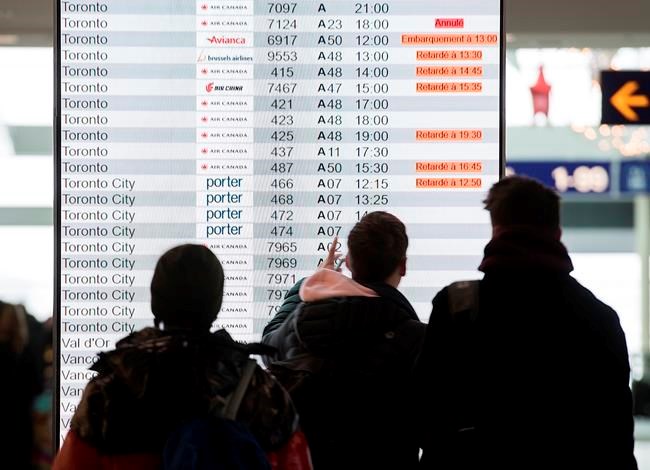MONTREAL — The country's two biggest airlines ranked last for on-time performance among large North American carriers last month, a new report has found.
Nearly 28 per cent of Air Canada flights, or more than 8,700, landed late in October, placing the company ninth out of 10 airlines on the continent, according to aviation data company Cirium.
WestJet came last with nearly 29 per cent of arrivals touching down late — defined as more than 15 minutes after scheduled arrival.
The two airlines' on-time percentages hit 72 per cent and 71 per cent, respectively, falling short of the North American average of 80 per cent — itself the lowest performance of any of the regions tracked in the report, including Europe, Latin America and the Middle East and Africa. Delta Air Lines, United Airlines, Alaska Airlines and American Airlines all notched north of 85 per cent.
Nonetheless, Air Canada's outcome marks an improvement from its tally of 68 per cent the previous month and represents an even bigger gain from the summer.
WestJet confirmed Cirium's figures and said a myriad factors contributed to the results, "most notably a weather event that impacted our operations in Calgary at the end of the month."
"We are pleased with our year-to-date on-time performance and the meticulous planning that has gone into ensuring that our operations over peak travel periods have been safe and reliable for those that are travelling across our network each day," WestJet spokeswoman Madison Kruger said in an email.
Air Canada did not respond to requests for comment Monday.
In the past, it has pointed to a shortage of air traffic controllers, bad weather and a network running at full tilt amid high demand, which can mean longer recovery times after a disruption.
CEO Michael Rousseau has acknowledged Air Canada's relatively low ranking recently, including after a wave of flight delays in June and July.
Despite more staff and revamped technology, the carrier's operations failed to meet "expected levels," he told analysts on a conference call in August.
The chief executive identified "severe weather" — thunderstorms, in particular — and "global supply chain issues" as among the culprits.
"We're spending a lot of time improving our on-time performance," he said. Rousseau cited April and May as "very solid" and the subsequent two months as worse, when about half of all flights were late.
He also acknowledged that high load factors — when all planes are almost fully booked — do result in more "spilling traffic" after flights are cancelled, as passengers scramble to rebook with competitors and may arrive hours or days later than planned.
"If an airplane craps out, for whatever reason — mechanical things do happen — there's no backup," said John Gradek, who teaches aviation management at McGill University and worked at Air Canada for 18 years.
"They'd rather have the airplanes flying than airplanes hanging around just in case," he said. "The problem is, when the just-in-case does happen, you're in deep doo-doo."
Stretched capacity in the sector extends to labour as well, from pilots to baggage handlers. In July, the International Air Transport Association called out air traffic control organizations in North America, which include Nav Canada, for staffing shortages that "continue to produce unacceptable delays and disruptions."
Nav Canada has acknowledged that some delays at the country's biggest airports relate in part to a dearth of air traffic controllers.
As planes wait to land, that time spent circling the runway can tack on hours to flight crews' shifts each week, pushing them closer to their 28-day cap and leaving less leeway for them to fill schedule holes by month's end.
Meanwhile, late arrivals mean a smaller window to carry out preventive maintenance between flights overnight, which can result in mechanical issues and more delays down the line.
This report by The Canadian Press was first published Nov. 20, 2023.
Companies in this story: (TSX:AC)
Christopher Reynolds, The Canadian Press




